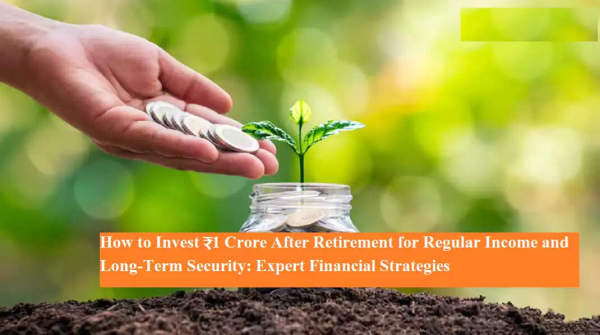
A Smart Retirement Plan Can Make ₹1 Crore Last 25–30 Years
Managing your retirement fund wisely is just as important as building it. Financial experts believe that if a ₹1 crore corpus is invested systematically and with discipline, it can comfortably cover your expenses for the next 25 to 30 years. The key, however, lies in protecting the capital while ensuring steady income growth.
Ajay Kumar Yadav, Group CEO of Wise Finserv, explains that the first step is to determine how much monthly income you’ll need after retirement for essential and lifestyle expenses. Once that is clear, you can create a diversified allocation strategy that balances safety and returns.
The Golden Rule: Never Risk Your Capital
Experts stress that retirees should prioritize capital preservation above all else. Losing your retirement corpus could jeopardize your financial stability for life.
Safer investment options such as fixed deposits (FDs), high-rated bonds, Senior Citizens’ Savings Scheme (SCSS), annuities, and debt mutual funds can provide around 8% CAGR returns while minimizing risk.
However, relying solely on fixed-income instruments can reduce your purchasing power over time. Inflation eats into returns, and after taxes, the real returns often shrink further. Therefore, you need to ensure that your investments also generate inflation-adjusted growth.
Inflation and Taxes: The Hidden Enemies of Retirement Funds
Inflation significantly affects retirement savings. Even if your investments yield 8% annually, inflation (typically 5–6%) can bring down your effective return to 2–3%. Add taxes to that, and your real gain diminishes even more.
This means that if you invest your entire ₹1 crore in FDs or bonds, your funds may not last for 25–30 years. To sustain long-term income, you need to diversify into assets that offer higher growth potential, such as equity mutual funds.
25–40% of Corpus Should Be in Equity
Financial planners recommend investing 25–40% of your retirement corpus in equity-based instruments to ensure your capital continues to grow.
Amit Suri, Founder and CFP at AUM Wealth, advises:
“Your annual withdrawal rate should always be lower than the growth rate of your equity portfolio. This allows compounding to work while you generate income.”
He suggests using Systematic Withdrawal Plans (SWPs) from mutual funds instead of withdrawing lump sums. Equity investments in large-cap funds, balanced funds, and multi-asset allocation funds are ideal for retirees who want both stability and growth.
Equity Can Deliver Up to 12% CAGR Returns
According to Yadav, funds such as multi-asset allocation and balanced advantage funds can be considered all-season investments.
These funds allow managers to shift exposure between equity, debt, gold, and silver depending on market conditions. Over the long term, such diversified funds can generate up to 12% CAGR returns, outperforming traditional instruments.
Additionally, equity investments are tax-efficient. Under the new tax regime, income up to ₹12 lakh per year is tax-free. Long-term capital gains over ₹1.25 lakh are taxed at 12.5%, while short-term gains are taxed at 20%—still favorable compared to high taxation on interest income from FDs.
A Practical Example: How to Balance the Portfolio
Let’s consider a retiree with ₹1 crore savings.
If they invest 60–75% in safe fixed-income instruments, they could earn around ₹4.8 lakh annually. The remaining 25–40% invested in mutual funds through SWPs can supplement regular income and counter inflation.
Instead of withdrawing a fixed sum every month, SWPs can be adjusted periodically to reflect market returns. This strategy helps maintain a steady monthly income without putting pressure on the portfolio.
With balanced withdrawals, compounding growth, and market-linked returns, a well-structured plan ensures your retirement corpus not only lasts your lifetime but also leaves a legacy for the next generation.
Key Takeaways for a Safe and Profitable Retirement
-
💰 Capital Safety First: Choose low-risk, high-credit-quality instruments.
-
📈 Equity Exposure: Keep 25–40% in equities for long-term growth.
-
🧮 Account for Inflation: Always calculate real returns after inflation and tax.
-
🔁 Use SWPs: Generate regular income without breaking compounding.
-
🧠 Diversify: Combine debt, equity, and hybrid funds for stability.
-
🧾 Stay Tax-Efficient: Use schemes and funds that minimize your tax burden.
Conclusion:
A well-planned retirement portfolio is all about balance — between risk and reward, income and growth, safety and opportunity. With the right mix of equity, debt, and hybrid investments, your ₹1 crore corpus can ensure steady monthly income, preserve your capital, and keep your financial future secure for decades to come.
-
Typhoon Matmo Impact: Heavy Winds Almost Swept Away Man With His Door; Viral Video Sparks Scare

-
Sudden cardiac death: Why do people die suddenly from heart attacks? Learn more and be vigilant now

-
South Korea: Highways partially congested on Chuseok holiday

-
South Korea: Highways partially congested on Chuseok holiday

-
NTPC Bongaigaon Extends Support to Young Football Talent from Salakati-Revised
